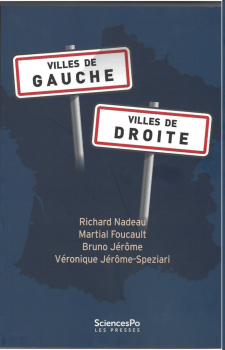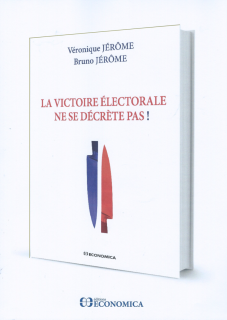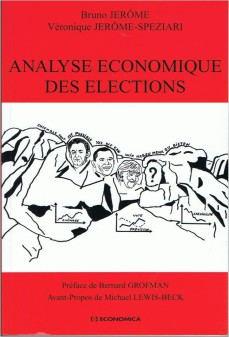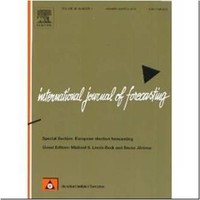International Journal of Forecasting
Volume 26, number 1.
January-March 2010
Special issue
http://www.sciencedirect.com/science/journal/01692070/26/1
Guest Editors
Michael S. Lewis-Beck
Department of Political Science
University of Iowa
Bruno Jêrôme
Faculty of Economics
University of Paris II
EUROPEAN ELECTION FORECASTING: AN INTRODUCTION
In the United States, considerable attention is paid to election forecasting. For the 2008 presidential contest, scientific forecasters were often in the press, making prognostications about the Obama-McCain race. (See the articles in PS: Political Science and Politics, No.1, Vol. 42, 2009). National election forecasting has developed a vigorous American tradition, as the recent special issue of this journal, on US presidential contests, makes clear (Campbell and Lewis-Beck, 2008). The extent of American activity might be taken to imply a dearth of attention elsewhere. Such is not the case, as evidenced by this special journal section on European election forecasting. As regards European countries, since three decades, Political Economists and Political Scientists had a particular focus on Economic Voting determinants, more recently in a comparative way (Lewis-Beck, 1988; Lewis-Beck and Paldam, 2000; Jérôme, Jérôme-Speziari and Lewis-Beck, 2001). However, regarding electoral forecasting, few countries have been investigated with the exception of the “G3”, France, Germany, and United-Kingdom. Despite the differences in these political systems from each other, and from the United States, good scientific forecasting work has proved possible with noteworthy extensions to new countries.
These papers are authored by leading political scientists and economists, well-known election forecasters in their home countries. The national elections under investigation here, as individual case studies, are those of France, Germany, Italy, and Spain. For France, where election forecasting is relatively advanced, three different articles are presented. The first, by Nadeau, Lewis-Beck, and Bélanger, unfolds a two-step forecasting model of French presidential elections, including the difficult, and most recent, 2007 contest. The second, by Evans and Arzheimer, focuses on forecasting legislative elections from regional economic data, a too-often neglected source. The third, by Lemmenicier, takes a special approach, applying a Downsian median voter model to predict outcomes in the 577 constituencies. The German example, by Norpoth and Gschwend, develops their pioneering Chancellor model to predict ruling coalition support from past partisanship, government popularity, and time in office. Bellucci takes cues here, arriving at a similar model for Italy, after demonstrating, for the first time, a satisfactory prediction equation for Italian government popularity.
There are at least two basic approaches to election forecasting, models v. polls. The models usually rest on explanation of the electoral behavior (from a set of structural variables), while the polls rest on prediction (from a proximate electoral outcome surrogate, such as vote intention). The most common explanatory models posit electoral outcome as a function of substantive political economic variables, such as government approval or economic growth. The papers in this section all offer explanatory models of this type, with the exception of that by Lemennicer on France, and Pavia on Spain.
Lemmenicier does offer an explanatory model, but of a different type. Uniquely, he posits a Downsian median voter model, based on party strategies rather than voter strategies. For Spain, Pavia looks at exit polls, which can provide forecasts as close as possible prior to the election itself. All the papers aim to predict a general election outcome, e.g., an overall vote share of a party (coalition), with the exception of the Evans and Ivaldi effort, who offer a valuable comparative analysis of the radical right vote. . A further cross-national analysis is that of Jêrôme and Jêrôme-Speziari, who forecast the partisan cycles of 130 national elections (1978-2008) relying on a SUR model. This analysis of “Euroland” taken as a single geo-political unit represents the most ambitious in the collection.
Last, but not least, it must be emphasized that these are true efforts at forecasting. That is to say, the models and methods allow prediction of the election outcome before (sometimes months before) the actual election event itself. Thus, the papers jump the hurdle of mere confirmatory science, to tackle the more demanding hurdle of accurate ex ante precision.
REFERENCES
Campbell, James, and Michael S. Lewis-Beck, eds. 2008. Special Issue, “Presidential Election Forecasting,” International Journal of Forecasting, Vol.24, No.2, April-June 2008.
Jérôme, Bruno, Véronique Jérôme-Speziari and Michael S. Lewis-Beck. 2001. « Evaluation économique et vote en France et en Allemagne », in L’opinion Européenne, D. Reynié et B. Cautrès eds, Presses de Sciences Po, 25 avril.
Lewis-Beck, Michael. S. 1988. Economics and Elections: The Major Western Democracies, Ann Arbor: University Michigan Press, 1988.
Lewis-Beck, Michael S., and Martin Paldam, eds. 2000. Special Issue, “Economics and Elections”, Electoral Studies, Vol.19, N°2/3, June-September 2000.





